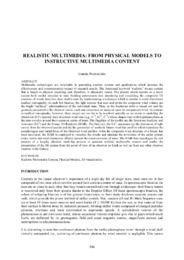| dc.contributor.author | Pachoulakis, Ioannis | en |
| dc.coverage.spatial | CY - Λευκωσία | en |
| dc.creator | Pachoulakis, Ioannis | en |
| dc.date.accessioned | 2016-02-02T08:34:13Z | |
| dc.date.available | 2016-02-02T08:34:13Z | |
| dc.date.issued | 2007 | |
| dc.identifier.uri | http://hdl.handle.net/10797/14557 | en |
| dc.description | Περιέχει το πλήρες κείμενο | el |
| dc.description.abstract | Multimedia technologies are invaluable in generating realistic content and applications which increase the
effectiveness and communication impact of research results. The functional keyword “realistic” means content
that is based on physical modeling and, therefore, is physically sound. The present article reports on a novel
custom-built toolkit intended to train budding astronomers into simulating and visualizing the composite 3D
structure of winds from hot close double stars by implementing a technique which is similar to multi-directional
medical tomography. In such hot binaries, the light sources that scan and probe the composite wind volume are
the bright “surfaces” (photospheres) of the individual stars. Then, as the Keplerian orbit is traced out and the
geometry presented to the observer varies, each star constitutes an analyzer upon its companion's wind. In contrast
to medical tomography, however, these targets are too far to be resolved spatially so we resort to modeling the
ultraviolet (UV) spectral lines of certain wind ions (e.g., N+4, Si+3, C+3) whose shapes vary with Keplerian phase as
the stars revolve around their common centre of mass. The flagships of the toolkit are the Spectrum Analyzer and
Animator (SA2) and the Binary 3D Renderer (B3dR). The first tool, the SA2, automates (a) the derivation of light
curves from the observed spectra and (b) the generation of synthetic binary wind-line profiles which reproduce the
morphologies and variabilities of the observed wind profiles. After the composite wind structure of a binary has
been recovered, the B3dR is employed to visualize the results and simulate the revolution of the entire system
(stars, winds and wind-interaction effects) around the common centre of mass. The B3dR thus repackages the end
product of a lengthy physical modeling process to generate realistic multimedia content and enable the
presentation of the 3D system from the point of view of an observer on Earth as well as from any other observer
location in the Galaxy. | en |
| dc.language.iso | eng | en |
| dc.publisher | University of Cyprus | en |
| dc.relation.ispartof | Information and communication technology | en |
| dc.rights | info:eu-repo/semantics/openAccess | en |
| dc.rights | Open Access | en |
| dc.source | CBLIS Conference Proceedings 2007 Contemporary Perspective on new technologies in science and education | en |
| dc.title | Realistic multimedia: from physical models to Instructive multimedia content | en |
| dc.type | info:eu-repo/semantics/conferenceObject | en |
| dc.subject.uncontrolledterm | Realistic Multimedia Content | en |
| dc.subject.uncontrolledterm | Physical Models | en |
| dc.subject.uncontrolledterm | 3D visualization | en |
| dc.contributor.conferenceorganizer | Learning in Science Group, University of Cyprus | en |
| dc.contributor.coordinator | Constantinou, Constantinos P. | en |
